


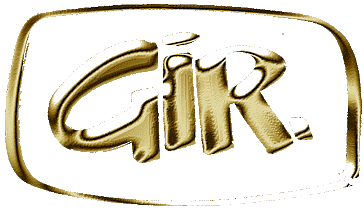 &
&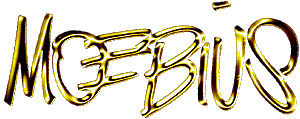
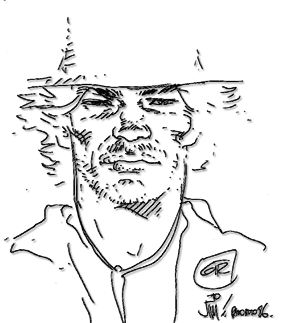
 With Jean Giraud
you have a lot of options. Currently he's best known as "Moebius",
a nom de plume he adopted in the Sixties. But I'm getting ahead
of myself. He was born in Paris in 1938 and discovered the escapist
world of science fiction and fantasy art early in life. He grew
up with comic books and was creating his own all through his adolescence.
He had some formal training at the Institute of Applied Art, but
his real school was the French comic medium.
With Jean Giraud
you have a lot of options. Currently he's best known as "Moebius",
a nom de plume he adopted in the Sixties. But I'm getting ahead
of myself. He was born in Paris in 1938 and discovered the escapist
world of science fiction and fantasy art early in life. He grew
up with comic books and was creating his own all through his adolescence.
He had some formal training at the Institute of Applied Art, but
his real school was the French comic medium.
In 1956, before he was 18, he was drawing his own comic strip, Frank et Jeremie for the magazine, Far West. Throughout the rest of the fifties he drew comics.
Perhaps an aside is warranted here. French comics of the fifties through the seventies were usually weekly publications with a wide variety of material, but usually only a couple of pages were devoted to each strip. So if I told you he contributed to 20 issues of Fripounet et Marisette from 1956-1958, the total number of pages drawn might only amount to around 25. I don't want to minimize the work he was doing at a considerably early age, but I don't want to distort it out of proportion either.
His main market was a pair of Catholic magazines, Ames vaillantes and Coeurs vaillants for which he would do short (2-4 page) strips and the occasional cover. 1958 and 1959 were mainly taken up with military service (I think - my French is rudimentary, at best), and early in 1961, he apprenticed to Joseph Gillian. Known as Jijé, Gillian was an established cartoonist working for the major comic magazines. Together they produced 44 pages of Jerry Spring, a western strip for Spirou over a period of five months. This exposure led directly to Blueberry, the strip he created with Jean-Michel Charlier and for which he's best known.
Blueberry started in Pilote #210 (dated October 31, 1963) and the first story was titled Fort Navaho. It was 46 color pages - the perfect length to be published as an album. Jijé actually did the album cover.
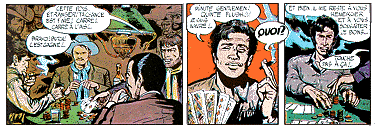 |
|
Mike Blueberry was Jean Paul Belmondo in a John Ford
western storyboarded by Harvey Kurtzman. There, I finally got to say it! |
| Of course it didn't stay that way for long. Giraud was destined to grow and change and improve and despite Blueberry's longevity (the last volume I've seen is Arizona Love [below] from 1990), the style was anything but static. The journey from there to here is most interesting. |
 |
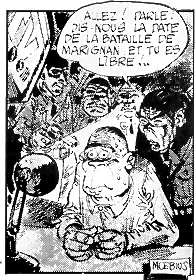
|
It was also in 1963 that Moebius was born. In an obscure satire magazine called Hara Kiri, in a style reminiscent of Kurtzman's Mad Magazine crew, a new artist made an unheralded arrival. That little signature box at left is the first appearance of Giraud's use of Moebius. I don't know for sure, but I'm willing to bet that few readers made the stylistic connection between this style and the one signed Giraud in Pilote. Moebius did 21 strips for Hara Kiri in 1963 and 1964 and then disappeared for nearly a decade. |
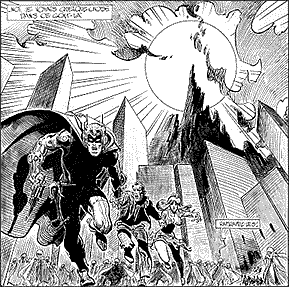 Throughout
the Sixties and into the Seventies, Giraud continued to produce
Blueberry episodes and albums on a regular basis.
In addition, as Gir, he did many other stories, also for Pilote.
Some he drew and some were written for other artists like Auclair
and Tardi. His style as Gir was more explosive and explorative
and, in many cases (see image at right from Y a Pas Moyen,
Pilote #645, 3/16/72) very much in the manner of American
comic books. Giraud was about to take his style even further.
In January of 1973, Pilote published La Deviation,
a seven page b&w strip depicting the surreal vacation of artist
Jean Giraud (see below). Signed "Gir", this strip evaporated
any doubts that Giraud and Moebius were the same person, and it also heralded a growing stylistic connection between Gir/Giraud and Moebius.
The cat was pretty much out of the bag.
Throughout
the Sixties and into the Seventies, Giraud continued to produce
Blueberry episodes and albums on a regular basis.
In addition, as Gir, he did many other stories, also for Pilote.
Some he drew and some were written for other artists like Auclair
and Tardi. His style as Gir was more explosive and explorative
and, in many cases (see image at right from Y a Pas Moyen,
Pilote #645, 3/16/72) very much in the manner of American
comic books. Giraud was about to take his style even further.
In January of 1973, Pilote published La Deviation,
a seven page b&w strip depicting the surreal vacation of artist
Jean Giraud (see below). Signed "Gir", this strip evaporated
any doubts that Giraud and Moebius were the same person, and it also heralded a growing stylistic connection between Gir/Giraud and Moebius.
The cat was pretty much out of the bag.
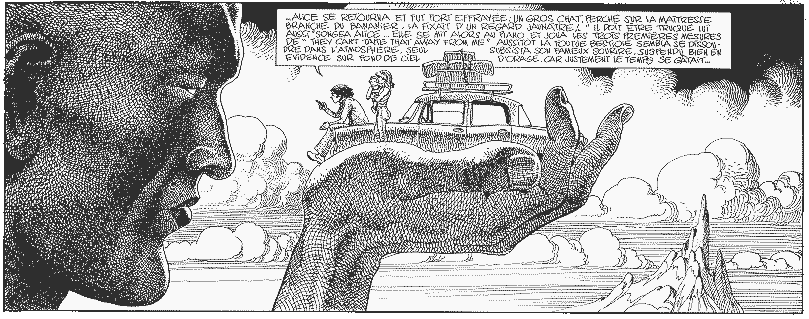
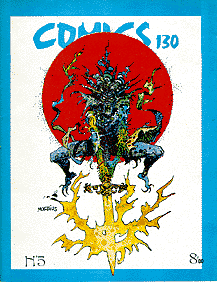 The
early Seventies in France also saw the rise of fanzines, just
as it did in the U.S. These magazines, assembled and published
by the people who collected the comics were often showcases for
new artists. When Moebius did the cover for Comics 130
#5 (10/71 - at left), it's not certain how many people actually
knew that Giraud was Moebius, but it is certain that the cover
art was powerful and in a new style.
The
early Seventies in France also saw the rise of fanzines, just
as it did in the U.S. These magazines, assembled and published
by the people who collected the comics were often showcases for
new artists. When Moebius did the cover for Comics 130
#5 (10/71 - at left), it's not certain how many people actually
knew that Giraud was Moebius, but it is certain that the cover
art was powerful and in a new style.
Soon Moebius art was turning up on the covers of science fiction paperbacks, in the French equivalent of underground comics (Le petit Mickey, Le Bandard Fou and L'Echo des Savanes), and then, in early 1975, as one of the founding members of Les Humanoides Associes (the others were Jean-Pierre Dionnet, Philippe Druillet, and Farkas). Their first publication, Metal Hurlant, would change comics forever. The first issue featured a cover by Moebius and Philippe Druillet, as well as the first installment of Arzach and of Major Grubert. (The American incarnation of Metal Hurlant is Heavy Metal which is still being published today and is filled, primarily, with European reprints.)
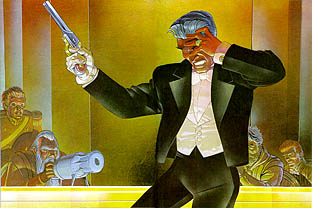 With
the advent of Metal Hurlant, Moebius came to the fore both
as France's most important cartoonist and as the dominant member
of the Giraud/Gir/Moebius trio. Throughout the Seventies, Moebius
appeared in every issue. Much of his work there has been collected
into albums: Harzak, John Water Color (which also
reprints the Hara Kiri and L'Echo des Savanes work),
Le Bandard Fou, L'homme est-il bon?, Major Fatal,
etc. In the early Eighties, LHA began a series of albums collecting
all of his work, from the earliest Frank et Jeremie
up to unpublished and seldom-seen work of the time. One image
(at right) from Le Desintegre Reintegre - (Moebius Oeuvres
Completes Tome 5, 1982) is indicative of his stylistic variety.
With
the advent of Metal Hurlant, Moebius came to the fore both
as France's most important cartoonist and as the dominant member
of the Giraud/Gir/Moebius trio. Throughout the Seventies, Moebius
appeared in every issue. Much of his work there has been collected
into albums: Harzak, John Water Color (which also
reprints the Hara Kiri and L'Echo des Savanes work),
Le Bandard Fou, L'homme est-il bon?, Major Fatal,
etc. In the early Eighties, LHA began a series of albums collecting
all of his work, from the earliest Frank et Jeremie
up to unpublished and seldom-seen work of the time. One image
(at right) from Le Desintegre Reintegre - (Moebius Oeuvres
Completes Tome 5, 1982) is indicative of his stylistic variety.
Other major accomplishments of the Seventies included costume designs for Ridley Scott's film, Alien and storyboards and design for Jodorowsky's Dune and Disney's Tron, the launch of a new western strip with Charlier, Jim Cutlass, and collaborations with both Jodorowsky and Dan O'Bannon. Albums, portfolios, posters and more. Blueberry continued to appear fairly regularly in Pilote and he started his famous L'Incal series in 1981. This three-album series brought Giraud's fascination with crystals into his mainstream work - and, yes, by 1981 Moebius was as mainstream as Giraud.

Much of Gir's work has been translated into English and published as soft-bound albums by Epic. There are about 20 of them including many of the best Blueberrys and the complete L'Incal. This same material has been issued by Graphitti Designs in limited edition signed hardcovers (about three albums per book) with wonderful commentary by Giraud.
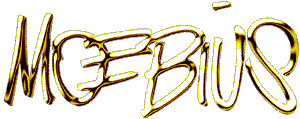
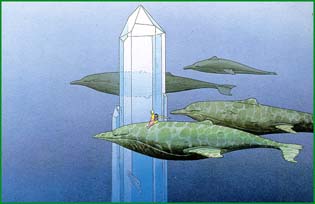 As
Moebius, Giraud defies easy classification. One minute he may
be depicting a serene encounter like the one shown at left and
the next project might be a hard-edged, sexually charged violent
image like that below right. Several of his most recent projects
have been explicitly erotic. Giraud was in our booth in San Diego
some years ago and Karen was looking at his then-just-released Angel
Claw. She looked at the images and then at Giraud and said,
"I'm sure glad you've got an outlet." When the connotations
were translated to him, Giraud laughed and agreed.
As
Moebius, Giraud defies easy classification. One minute he may
be depicting a serene encounter like the one shown at left and
the next project might be a hard-edged, sexually charged violent
image like that below right. Several of his most recent projects
have been explicitly erotic. Giraud was in our booth in San Diego
some years ago and Karen was looking at his then-just-released Angel
Claw. She looked at the images and then at Giraud and said,
"I'm sure glad you've got an outlet." When the connotations
were translated to him, Giraud laughed and agreed.
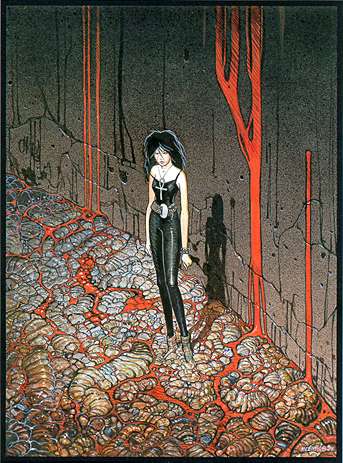 He did a
popular series of superhero posters for Marvel Comics in the Eighties
as well as a variety of prints from his own StarWatcher Graphics.
I've always been taken with his single images from the day in
1973 when I saw his Blueberry posters for sale at
the Paris Airport. His storytelling can be very abstract as Moebius
and the images done for prints are usually self-contained and
more accessible. It's all a matter of taste.
He did a
popular series of superhero posters for Marvel Comics in the Eighties
as well as a variety of prints from his own StarWatcher Graphics.
I've always been taken with his single images from the day in
1973 when I saw his Blueberry posters for sale at
the Paris Airport. His storytelling can be very abstract as Moebius
and the images done for prints are usually self-contained and
more accessible. It's all a matter of taste.
 The
fascination with things crystalline impacts many of the strips
and images executed in the Eighties and Nineties. He wrote and
designed a trio of albums with Bati called The Magic Crystal
- intended for a younger audience. They were published in the
U.S. by ComCat, a division of Catalan Communications which also
published color collections of his Young Blueberry
strips done in b&w for Junior Pocket Pilote in the
Sixties.
The
fascination with things crystalline impacts many of the strips
and images executed in the Eighties and Nineties. He wrote and
designed a trio of albums with Bati called The Magic Crystal
- intended for a younger audience. They were published in the
U.S. by ComCat, a division of Catalan Communications which also
published color collections of his Young Blueberry
strips done in b&w for Junior Pocket Pilote in the
Sixties.
City of Fire was a fascination portfolio of illustrations
by Geoff Darrow that Moebius inked and colored. It was published
in France in 1985 in an edition of 100 with a U.S. edition done
by Dark Horse a decade later. Other portfolios for Aedena and
others were released in the Eighties.
 To learn more about Jean Giraud/Moebius see:
To learn more about Jean Giraud/Moebius see:| The Encyclopedia of Comics | Maurice Horn, 1976 Chelsea House |
| Masters of Comic Book Art | P.R. Garriock, 1978 Images Graphiques |
| Moebius (in French) | 1980 Les Humanoides Associes |
| Dr. Gir et Monsieur Moebius (in Italian) | 1983 Editori Del Grifo |
| L'Univers de Gir (in French) | 1986 Dargaud |
| The Vadeboncoeur Collection of Knowledge | Jim Vadeboncoeur, Jr. 1998 |
|
Illustrations are copyright by their respective owners. This page written, designed & © 1998 by Jim Vadeboncoeur, Jr. Updated 2011. |
Learn about other ILLUSTRATORS.